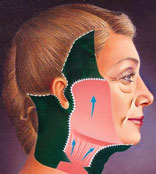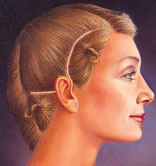Facelift
When people advance in age, the effects of gravity, sun exposure and daily life concerns can be seen on their face. Deep wrinkles will appear between the nose and the mouth; the line of the jaw becomes loose and flaccid; the folds and fat deposits of the skin appear around the neck. The operation known as facelift (or more technically as a rhytidectomy) is the surgical procedure by means of which it is sought to reposition facial tissues that have lost their tonicity and therefore fall as a result of gravity and aging. Aging is a gradual process that in the case of the face not only affects the skin, but also other structures, such as subcutaneous fat, muscles and facial bones. The face lift can not stop this aging process. What you can do is “turn the clock back,” by improving the most visible signs of aging by extracting excess fat, by grinding the inner muscles and reattaching the skin of your face and neck. You can only perform facelift surgery, if you wish, or simultaneously with other procedures such as correction of some alteration in the eyelids by aging or any other surgery, as well as treatments on the skin, either to correct the Fine wrinkles due to sun exposure and aging.
The best candidates
The best candidate for a rhytidectomy is a man or woman whose face and neck have begun to look flabby but whose skin still has some elasticity and whose bone structure is strong and well defined. The majority of patients are from the age of forty, however age does not present a contraindication to perform this surgery and people who have a family characteristic of excess or flaccidness of the skin, can request correction at more ages early A stretch of the facial skin can make you look younger and your skin look fresher, it can also improve the confidence you feel in yourself. It can not, however, give it a totally different appearance nor can it restore the health and vitality of its youth. Physically healthy people, psychologically stable and realistic with their expectations, may be good candidates.
Planning your surgery
Rhytidectomies are very individualized procedures. When making the initial consultation we will evaluate your face including the skin and bone structure. We will also evaluate the convenience of jointly treating the eyelids or other associated procedure. Do not forget to tell us if you smoke, are hypertensive or are taking any type of drug or medication, especially aspirin or other medicines that affect blood clotting.
Getting ready for your surgery
We will give you specific instructions on how to prepare for surgery, including certain rules about what to eat and drink, how to smoke and what vitamins or medications to take or avoid. Following these instructions very closely will help your surgery to be performed more effectively and with fewer obstacles. If you smoke, it is especially important to stop at least a week or two before and after surgery because smoking inhibits blood flow to the skin and this may interfere with the healing of the incision areas. Be sure to arrange for someone to accompany you home after surgery and to help you for a day or two if you need it.
Where will your surgery be done?
The breast implants surgery is performed in the clinic, which has all the necessary medical equipment, and the greatest comfort for you. You must arrive about 30 minutes before the scheduled time, to complete the admission procedures, prepare a complete medical history, and take preoperative photographs. In your room you can change clothes. After the surgery, he will stay in the clinic for two to four hours, until we make sure everything is in order and he can return to his home, where he will continue to rest.
Types of anesthesia
Facial Lifting is usually done under local anesthesia. The area to be operated will be asleep, as will the deeper tissues. This anesthesia is frequently associated with a sedation that will be administered orally or intravenously. You will be awake, relaxed, and insensitive to pain. Occasionally you may feel some small pain or discomfort during the administration of local anesthesia, similar to what you may experience at the dentist, but that disappears in seconds.
Surgery


 The stretching of the facial skin usually takes 2 to 3 hours, depending on the extent of the surgery, or sometimes more when more than one procedure is performed, for example a correction of the eyelids. In a typical procedure, the incisions are made following the natural lines of the skin. The scars will be hidden inside the hair and within the normal folds of your skin, in the places where a change of area is observed, that is, at the edge of the hairline, or in the case of the area of the ears. , on the edge where the face ends and the ear begins. Usually the incisions begin at the line of the scalp on the temples, extend with a natural line towards the front of the ear (or just inside the cartilage towards the front of your ear), and continue behind the ear toward the ear. lower area of the scalp. If it is necessary to work on the neck, a small incision can also be made below the chin. After surgery, a small, thin tube may be placed under the skin for 24 to 48 hours behind the ear to drain any blood that may accumulate there. After surgery your head will be covered with bandages at the level of the cheeks, leaving your face uncovered, to minimize bruising and inflammation.
The stretching of the facial skin usually takes 2 to 3 hours, depending on the extent of the surgery, or sometimes more when more than one procedure is performed, for example a correction of the eyelids. In a typical procedure, the incisions are made following the natural lines of the skin. The scars will be hidden inside the hair and within the normal folds of your skin, in the places where a change of area is observed, that is, at the edge of the hairline, or in the case of the area of the ears. , on the edge where the face ends and the ear begins. Usually the incisions begin at the line of the scalp on the temples, extend with a natural line towards the front of the ear (or just inside the cartilage towards the front of your ear), and continue behind the ear toward the ear. lower area of the scalp. If it is necessary to work on the neck, a small incision can also be made below the chin. After surgery, a small, thin tube may be placed under the skin for 24 to 48 hours behind the ear to drain any blood that may accumulate there. After surgery your head will be covered with bandages at the level of the cheeks, leaving your face uncovered, to minimize bruising and inflammation.
After surgery
In one or two days you should be standing and performing your normal tasks, however plan to perform light tasks for the first week after surgery. Be especially gentle with your face and hair, as your skin will be sensitive to pain and numb. We will give you specific instructions to gradually continue with your normal activities. Among the suggestions we will give you are: avoid strenuous activities, including sexual activity and heavy housework for at least two weeks (it is okay to walk or stretch slightly); avoid alcohol, smoke and be in closed areas in contact with smokers, steam baths and saunas for several weeks. You may be somewhat hypersensitive for a few weeks, therefore it will be advisable to use sun glasses, and sunscreen for the times when you are away from home. At first, your face may look and feel a bit strange. Most patients return to work after ten days. If necessary, some makeup can be used to cover any bruises that may remain.
Your new look
The scars tend to be imperceptible very soon, in less than two months, your face will look pretty close to the final result. You should remember that scarring is a gradual process and in some cases the scars may look pink for a few months before they clear up to a fine white line. After the surgery you will present a fresher and rejuvenated face to the world, keeping your own features.


